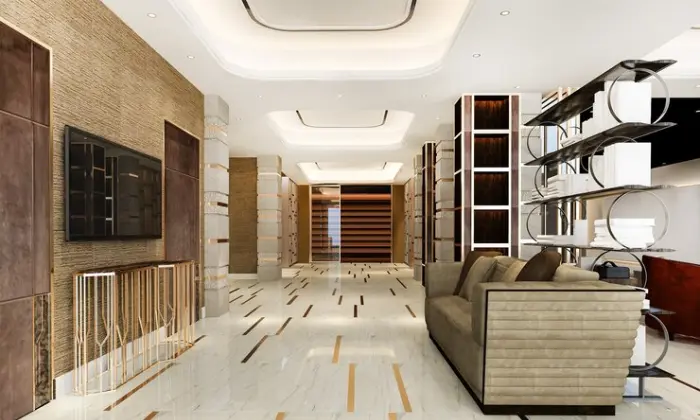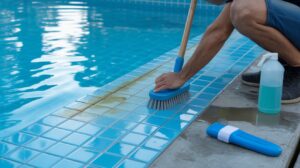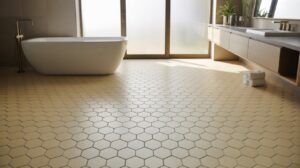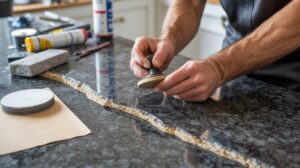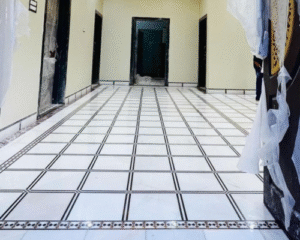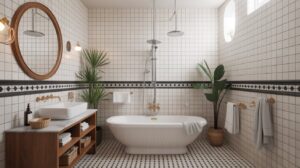Marble Epoxy Floor: Look, Benefits, and Cost Guide
If you’re considering upgrading your flooring, epoxy floor offers an exceptional blend of elegance and durability. This guide will walk you through everything you need to know, from the aesthetics and benefits to cost considerations and installation processes. Whether you’re a homeowner looking to elevate your interior design or a business owner seeking a durable flooring solution, a marble epoxy floor might be the perfect choice for you.
The Look of a Marble Epoxy Floor
They are known for their stunning, luxurious appearance. They replicate the elegant and timeless beauty of natural marble while offering the durability and versatility of epoxy. This unique combination makes marble epoxy flooring a popular choice for those looking to enhance their interior spaces with a high-end look.
Table of Contents
ToggleAchieving the Marble Look
The marble look in epoxy floors is achieved by mixing epoxy resin with metallic pigments and other additives. These components create a swirling, marbled effect that mimics the natural veining and color variations found in real marble. The result is a glossy, seamless finish that can transform any room into a sophisticated and stylish space.
Design Options
One of the key advantages of marble epoxy floors is the wide range of design options available. You can choose from various color schemes, from classic white and black marble looks to more unique and vibrant hues. The use of metallic pigments can add depth and dimension to the floor, creating a truly unique and eye-catching effect.
Whether you prefer a subtle, understated look or a bold, dramatic statement, marble look epoxy floors can be customized to match your aesthetic preferences. This flexibility makes them suitable for a variety of settings, including homes, offices, retail spaces, and more.
The Benefits of a Marble Epoxy Floor
They offer a range of benefits that make them an attractive choice for both residential and commercial spaces. Here are some key advantages:
Aesthetic Appeal
It provides the luxurious look of natural marble at a fraction of the cost. The high-gloss finish and customizable designs allow you to create a sophisticated and stylish atmosphere in any room. Whether you prefer a classic white marble effect or a bold, modern design, marble epoxy floors can enhance the visual appeal of your space.
Durability
Epoxy is a highly durable material that can withstand heavy foot traffic, making it ideal for high-use areas like kitchens, bathrooms, and commercial spaces. It is resistant to scratches, cracks, and stains, ensuring that your floor maintains its beauty over time.
Easy Maintenance
They are non-porous, meaning they do not absorb spills or stains. This makes them incredibly easy to clean and maintain. A simple mop or wipe with a damp cloth is usually sufficient to keep the floor looking pristine, making it a practical choice for busy households and businesses.
Cost-Effectiveness
Compared to natural marble, epoxy flooring with marble is a more affordable option. They provide the same elegant look without the high cost associated with real marble. Additionally, their durability and low maintenance requirements can save you money in the long run.
Versatility
Marble epoxy floors can be installed over existing concrete floors, making them a versatile option for various settings. They are suitable for residential homes, commercial buildings, garages, basements, and more. The seamless application and wide range of design options allow for customization to suit any space.
The Cost of a Marble Epoxy Floor
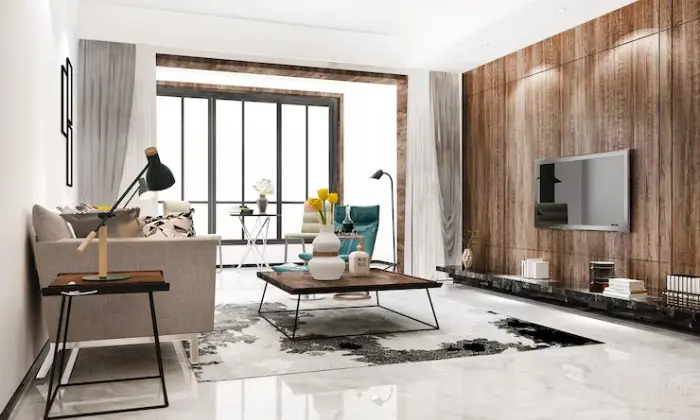
The cost of installing a marble epoxy floor can vary widely depending on several factors. Understanding these cost components can help you budget effectively for your project. Here’s a breakdown of the main factors influencing the cost:
Material Costs
The quality and type of epoxy resin, pigments, and additives used in creating the marble effect significantly impact the cost. High-quality materials, including premium epoxy and specialized pigments for unique designs, tend to be more expensive. Additionally, the cost can vary depending on whether you purchase a complete epoxy floor kit or individual components.
Labor Costs
Labor costs can vary based on the complexity of the design, the condition of the existing floor, and the experience level of the contractor. Professional installation is recommended for the best results, especially if you’re looking for a specific marble effect or intricate design. Hiring skilled professionals ensures proper preparation, application, and finishing, which can affect both the durability and appearance of the floor.
Area Size
The size of the area to be covered plays a significant role in determining the overall cost. Larger spaces require more materials and labor, increasing the total expense. Costs are typically calculated per square foot, so measuring the area accurately is crucial for obtaining a precise estimate.
Additional Features and Coatings
If you opt for additional features such as a metallic finish, anti-slip additives, or multiple top coats for extra durability and shine, these can add to the overall cost. These enhancements can improve the floor’s functionality and longevity but come at an extra cost.
Preparation Work
The condition of the existing floor can also influence the cost. If the surface requires extensive preparation, such as cleaning, repairing cracks, or leveling, these tasks can add to the labor costs. Proper preparation is essential for ensuring that the epoxy adheres well and provides a long-lasting finish.
Marble Epoxy Floor Coatings
Marble epoxy floor coatings are essential for achieving the desired aesthetic and durability in your flooring project. These coatings consist of multiple layers, each serving a specific purpose to enhance the appearance, protect the surface, and increase the longevity of the floor. Here’s a detailed overview of the different types of coatings used in white and black marble epoxy floors:
Epoxy Primer
The epoxy primer is the foundational layer applied directly to the prepared concrete surface. Its primary function is to create a strong bond between the concrete and the subsequent layers of epoxy. This ensures that the flooring system adheres properly and prevents issues like peeling or bubbling. The primer also helps seal the concrete, reducing the risk of moisture and air pockets, which can compromise the finish.
Base Coat
The base coat is the first layer of epoxy applied over the primer. It serves as the canvas for the marble design and is typically where the primary color and patterns are established. This coat can be customized with a variety of pigments and additives to achieve the desired look. For a marble effect, pigments are swirled into the epoxy, creating the characteristic veining and color variations of natural marble.
Metallic Coating
To enhance the marble look, a metallic coating can be added. This layer contains metallic pigments that create a reflective, three-dimensional effect, giving the floor a unique and luxurious appearance. The metallic pigments can be manipulated during application to create different patterns and depths, allowing for a wide range of design possibilities. This step is crucial for achieving the high-end, polished look that marble epoxy floors are known for.
Top Coat
The top coat is the protective layer that seals the entire flooring system. It provides a glossy finish and acts as a barrier against stains, scratches, and wear. This coat also enhances the floor’s resistance to chemicals, making it ideal for areas prone to spills or heavy use. Depending on the desired finish, the top coat can be customized to achieve a high gloss, satin, or matte look.
Clear Coat
In some cases, a clear coat may be applied as an additional protective layer. This layer adds depth and shine to the floor, enhancing the overall appearance. It also provides an extra layer of protection against UV rays, preventing discoloration and maintaining the floor’s vibrant look over time.
How to Install Metallic Epoxy Floor: Installation Process and Instructions
Installing a metallic epoxy floor involves several crucial steps to achieve a beautiful, durable finish. The process requires precision and the right materials, making professional installation highly recommended. However, if you’re considering a DIY approach, here’s a step-by-step guide to help you through the process:
Preparation
Surface Cleaning and Repair
Clean the Surface: Remove all dirt, oil, and debris from the concrete floor. A clean surface ensures better adhesion.
Repair Damages: Fill in any cracks or holes with epoxy filler and smooth out uneven areas.
Surface Preparation
Grinding or Acid Etching: Use a floor grinder or acid etch the concrete to create a rough surface for the epoxy to bond with.
Applying the Epoxy Primer
Mixing and Applying
Mix the primer components as per the manufacturer’s instructions and apply it evenly across the floor. This layer helps the epoxy adhere to the concrete.
Applying the Base Coat
Color Application
Mix the base coat with the desired color pigments and spread it evenly on the floor. This layer sets the foundation for the metallic effects.
Creating the Metallic Effect
Mixing Metallic Pigments
Add metallic pigments to the epoxy and mix thoroughly. These pigments give the floor its distinctive marbled look.
Application Techniques
Pour the metallic epoxy onto the base coat and use tools like brushes or rollers to create patterns. Experiment with swirling or feathering techniques for a unique effect.
Applying the Top Coat
Final Layer
Apply a clear top coat to protect the metallic design and give the floor a glossy finish. This layer also enhances durability.
PROs and CONs of Using Epoxy on Concrete Floors
Epoxy coatings are a popular choice for concrete floors due to their durability and aesthetic appeal. However, like any flooring option, they come with their own set of advantages and disadvantages. Here’s a balanced look at the pros and cons of using epoxy on concrete floors:
PROs
Durability
- Long-Lasting: Epoxy coatings are highly resistant to wear and tear, making them ideal for high-traffic areas. They can withstand heavy loads and impact, which prolongs the lifespan of your flooring.
- Chemical Resistance: Epoxy floors are resistant to chemicals, oils, and solvents, making them suitable for industrial and commercial environments where spills are common.
Aesthetic Appeal
- Customizable Designs: Epoxy floors come in various colors and finishes, including metallic and glossy options. This flexibility allows you to create a customized look that enhances the visual appeal of your space.
- Seamless Finish: The application process creates a smooth, seamless surface that eliminates grout lines and joints, giving your floor a sleek and modern appearance.
Easy Maintenance
- Low Maintenance: Epoxy floors are non-porous, making them easy to clean. Spills and stains can be wiped away easily, reducing the need for intensive cleaning routines.
- Resistance to Mold and Mildew: The non-porous nature of epoxy prevents the growth of mold and mildew, making it a hygienic choice for areas prone to moisture.
Cost-Effectiveness
- Affordable Option: Compared to natural stone or high-end tiles, epoxy flooring is generally more cost-effective. It offers a high-end look without the high price tag.
CONs
Application Challenges
- Complex Installation: Proper installation is crucial for the longevity of epoxy floors. If not applied correctly, issues like peeling, bubbling, or uneven surfaces can occur. Professional installation is often recommended to ensure the best results.
- Preparation Required: The surface must be properly prepared before application, which may involve cleaning, repairing, and etching. This preparation can add to the overall cost and effort.
Curing Time
- Long Curing Period: Epoxy floors require a curing period before they can be used. This period can range from 24 to 72 hours, during which the floor must remain undisturbed. This may cause inconvenience, especially in high-traffic areas.
Potential for Slipperiness
- Slippery Surface: Depending on the finish, epoxy floors can become slippery, particularly when wet. Adding an anti-slip additive to the top coat can mitigate this issue but may affect the appearance.
Susceptibility to UV Damage
- Color Fading: Epoxy floors can be prone to color fading when exposed to direct sunlight for extended periods. UV-resistant top coats can help reduce this issue but may add to the cost.
Limited Flexibility
- Not Suitable for All Surfaces: Epoxy coatings may not be suitable for surfaces with high moisture levels or excessive movement. In such cases, alternative flooring solutions might be more appropriate.
Where Else Can You Have Marble Epoxy?
Transform any hard surface with marble epoxy. Ideal for basements, garages, warehouses, and showrooms, marble epoxy brings luxury and durability to any space. Upgrade your floors with SF Marble And Granite Inc. for a stunning, resilient finish.
Who Can Install A Marble Epoxy Floor?
Both professional contractors and skilled DIY enthusiasts can install a marble epoxy floor, depending on the project’s complexity and desired outcome. Professional contractors, such as concrete coating specialists, have the expertise and equipment to ensure a high-quality finish.
Elevate Your Home with Expert Marble Floor Installation in Lowell
Transform your living space with the timeless elegance of marble flooring. At SF Marble & Granite Inc., we specialize in Marble Floor Installation in Lowell, delivering unparalleled craftsmanship and attention to detail. Our team ensures a seamless installation process, enhancing your home’s aesthetic appeal and value. With over a decade of experience serving the Lowell community, we are committed to providing high-quality materials and exceptional service. Trust SF Marble & Granite Inc. to bring sophistication and durability to your floors.
Conclusion
It is an excellent choice for anyone looking to enhance the aesthetic appeal and functionality of their space. With its stunning appearance, durability, and low maintenance requirements, it offers numerous benefits at a cost-effective price.
Transform your space with the elegance of a marble epoxy floor! Contact us today for a free quote and expert installation. Let us help you create a beautiful and durable floor that you’ll love for years to come.
FAQs
What is a marble epoxy floor?
It’s a flooring solution that mimics the luxurious look of natural marble, using epoxy resin mixed with pigments to create elegant, marbled patterns.
How does a marble epoxy floor compare to natural marble flooring?
Marble epoxy floors offer the same aesthetic appeal as natural marble but with added durability, easier maintenance, and a lower cost.
What are the main benefits of a marble epoxy floor?
They provide a high-end look, are durable under heavy traffic, easy to clean, and are cost-effective compared to real marble.
How long does it take to install a marble epoxy floor?
Installation times vary, but expect a curing period of 24 to 72 hours, with professional setup ensuring a smooth, lasting finish.
What factors affect the cost of a marble epoxy floor?
Costs depend on material quality, labor, the size of the area, and any additional features like metallic coatings or anti-slip additives.
How do I maintain my marble epoxy floor?
Regular cleaning with a damp mop or cloth is usually enough, thanks to its non-porous surface that resists spills and stains.

